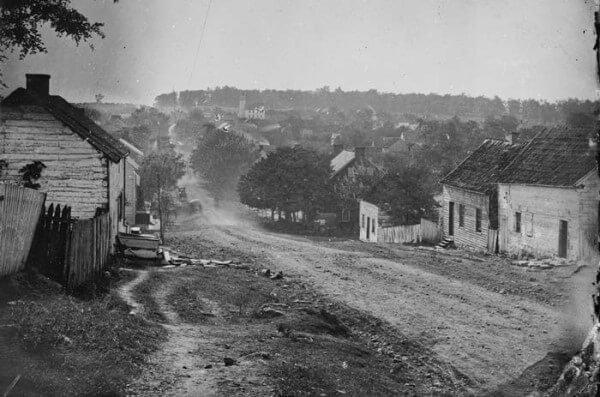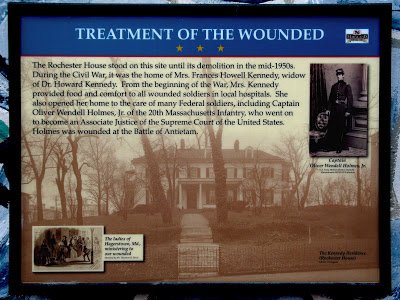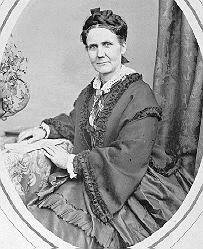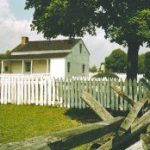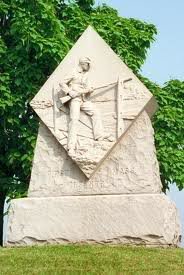The Mumma Family Lost Their Home at Antietam
 Image: Mumma Farm today
Image: Mumma Farm today
No one in the community around Sharpsburg, Maryland suffered more during the Battle of Antietam than the Mumma family. They escaped the battle, only to return to find their farm totally destroyed by a fire set by Confederate soldiers.
Backstory
Straddling the opposing sides both politically and geographically was the border state of Maryland. Despite the legislative efforts of the powerful slave holding minority, the majority of Maryland’s population was less committed to the institution of slavery. The farms around Sharpsburg were typical of the region where the primary crop was wheat, supplemented with corn, oats, and rye. Seasonal crops like wheat and corn did not require the year around labor that slavery provided, and most farmers relied on seasonal hired labor.
Mumma Family Flees
In September 1862, Samuel Mumma Sr., his wife Elizabeth (Miller) Mumma, and their ten children lived on a 150-acre farm on Smoketown Road, which Samuel inherited from his father Jacob in 1850. As troops approached Sharpsburg, the Mummas evacuated their home on September 15 – two days before the battle – and took refuge in a church a few miles to the north.
Their decision to flee was prophetic. Some of the first shots of the battle were fired from the high ground between the Mumma cemetery and Smoketown Road, a few hundred yards behind the house.
Brief Description of the Battle
At early dawn of Wednesday morning of September 17, 1862, the hills around Antietam Creek thundered with artillery and musketry. As the opposing armies struggled to possess the Cornfield of the David Miller farm, the battle lines swept back and forth across that strip of land for three hours.
By mid-morning, General Robert E. Lee‘s Confederate troops were hidden behind the high banks of a country lane that separated the Roulette and Piper farms. Wagons from the surrounding area had eroded the road and created a depression. While the sunken road allowed the Confederates to hide behind its steep embankments, it also kept the Union troops from view until they were within yards of the lane.
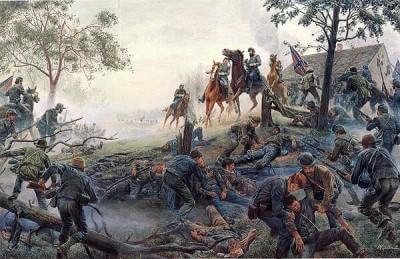 Image: Jackson at Antietam
Image: Jackson at Antietam
Artist Mort Kunstler explains how he created this painting:
I knew I wanted Dunker Church in the painting, but … Jackson had to be the center of interest. Since he was on horseback and was all over the battlefield, I could certainly place him near the church. … By moving around to the back of the church, I came across the rocky shelves … that were used to shelter the wounded. … I felt the key to the picture was to show the tremendous danger, with Jackson in the midst of this bedlam … It is 9:30 a.m. and the 7th Georgia charges back around the church to push the federals back. … I hope this painting gives the feeling of the way the battle was at this place and time, and also captures the true spirit and personality of Stonewall.
Because of the tragic death toll suffered there, the Sunken Road earned a new name: Bloody Lane. Charles Hale of the 5th New Hampshire Infantry, II Corps later wrote this account of his experiences during the Battle of Antietam:
What a bloody place was that sunken road as we advanced, and the Irish Brigade fell back; the fences were down on both sides, and the dead and wounded men were literally piled there in heaps. As we went over them in crossing the road, a wounded reb made a thrust at me with his bayonet; turning my head to look at him, I saw that he was badly hurt, and continued on. As we pushed forward into the [Piper] cornfield beyond the road … a strand of canister went over our heads, and that was my dread; I could endure rifle bullets, but when the big iron bullets went swishing through the air with a sound as though there were bushels of them, it made me wish I was at home.
By nightfall, the Rebels had taken possession of the nearby town of Sharpsburg, but the battle was considered a Union victory. More than 23,000 men were killed, wounded, or missing in action during that short span of time, from dawn until dusk. General Lee’s plan to find new recruits and supplies in Maryland had failed. He began his retreat across the Potomac River the following day.
The remaining Confederates then retreated toward Sharpsburg, covered by cannon fire from General Stonewall Jackson‘s artillery, and the Union troops fell back. General Ambrose Burnside came forward with a second Union attack, but Southern reinforcements arrived in time to repel his offensive.
The Fire
The Confederates became fearful that Union riflemen would use the farm buildings at Mumma Farm as sharpshooters’ nests. Therefore, approximately two hours into the battle, Southern troops set fire to the house, barn, spring house and hog pen. The column of fire and smoke was visible all morning above the battlefield. One Union soldier remembered:
Just in front of us a house was burning, and the fire and smoke, flashing of muskets and whizzing of bullets, yells of men … were perfectly horrible.
Care for the Wounded
Houses, barns and churches near the battle scene were used as hospitals to care for wounded soldiers. Daughters of Charity came from Emmitsburg to contribute their services. The Frederick Examiner reported:
In addition to the other nurses employed in the U.S.A. General Hospital at this city, ten Sisters of Charity from Emmitsburg were applied for, who arrived at the Hospital on Thursday last, and entered upon their duties. The engagement of these Sisters of Charity, who are schooled to the vocation, is very opportune.
The Sisters were instrumental in helping to establish better patient care and tended to the needs of both Union and Confederate soldiers. An untold number of soldiers and civilians died from disease following the battle. Dead men and horses lay out in the open for days, adding to the unsanitary conditions.
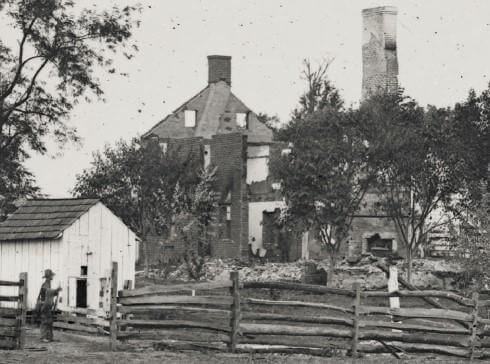
Image: Results of the fire at the Mumma Farm
The brick wall and chimneys are all that remains of the farmhouse
Photo by Alexander Gardner
Library of Congress
Ruins at Mumma Farm
When the Mumma family returned on September 19, they found only the smoking remains of their house, barn and outbuildings. They not only lost their home, they lost their personal belongings as well. The Mummas spent the winter at the Sherrick farm near Burnside’s Bridge. The Federal government repaid civilians for damages caused by Union soldiers; since their farm was destroyed by Confederates, the Mummas received no compensation. The following spring, they began to rebuild the structures on their farm with help from the community.
Voices from the Past
New Bern, NC
March 19, 1906
Dear Sir:
Please be so kind as to give me the correct name of the man who owned or lived in the brick house that was burned at the battle of Antietam or battle of Sharpsburg being called by both names. I belonged to the 3rd N.C. Infantry, Col. Wm. L. Derossette, Ripley’s Brigade, D.H. [Dana Harvey] Hill‘s Division. This house stood immediately in our front as the battle was being commenced and at times was in the enemies lines. General [Roswell] Ripley, to prevent its occupation by sharpshooters, and protect his officers from being picked off, ordered it to be burned.After firing the house, we all got back to our lines; myself being the only one hurt. Ripley ordered me to carry orders down to his line to 44th and 48th Ga. Regiment to come up and take a rail fence in their front. He [Ripley] was shot soon after I left him.
I carried the orders down to the Ga. troops and being weak from loss of blood, we went off field by an old church and on to our hospital. Then a woman young and beautiful and black haired helped to bandage my arm. Have often wondered if she was any of family living in the house. Please make all due inquiry as to family and where they went when caught between lines of battle. I wish to write up the particulars of the event truthfully, and there are some particulars about the family I would like to have. …
My brother, now deceased, said he saw the old gentleman or thought he talked with the owner of the house burned, and he
said he hoped the next time they fought, they would get out of his cornfields, as he gathered no corn or crops that year.Hoping to hear from you with line of particulars, as to where the family went that morning, Wed., Sept. 17, 1862, so far as l can recall, l am
Yours Respectfully & Truly
James F. Clark
Late Sergeant Major
3rd N.C. Reg.
This somewhat surprising response from Elizabeth and Samuel Mumma’s son:
Dear Sir:
In reply to your letter of Mar. 19, asking for some information concerning the burning of the brick house, on Sept. 17, 1 will say that the house referred to was owned by my father, Samuel Mumma Sr. The house, a large, brick colonial one, near the Dunker Church, was burned at the Battle of Antietam.My father was told the family had better get away, so we left on Monday afternoon the 15th, took nothing with us as they were cannonading then, and we were afraid there would be a battle at once. Some clothing was gotten together and the silverware packed in a basket, ready to take but in our haste to get away, all was left behind.
Father and Mother and the younger children left in the two horse carry-all (the older children walking as there was a large
family) going about four miles, and camped in a large church called (the Manor Church), where many others were also
congregated.On Tues. evening a friend and I came back to the house, thinking to get some clothing, but found that everything of value
had been taken. I then started for Sharpsburg, and at the ridge on the field above the house, where the line had formed, Gen. D.H. Hill and some other officers had me brought to them and questioned me as to whether I was a member of that family; and then asked me about the different roads to Antietam Creek. I gave him a correct statement, although I was a Unbn boy.After we left, my older brother Daniel came back to the house and went to bed. Towards morning, some officers knocked at the door. Daniel, being young also, was afraid to open the door, jumped out a back window, left it up, and spent the remainder of the night in an upper room of a stone building that was once used by their slaves. (Slaves had been freed.)
The next day he went to Sharpsburg. That morning the house & barn were burned, but we were told that Gen. Richardson’s
battery (a Union Gen.) shelled the barn and burnt it. Our family then went to a friend’s house and stayed until spring.In the spring of ’63 we rebuilt our house and had just moved in a few weeks before the army went to Gettysburg. As they were passing through to Gettysburg an officer approached me and asked me if I knew who had burnt that house. I told him I did not; then he told me that he and eight other men were detailed by Gen. Ripley to burn the house, and that he picked up a chunk of fire from where they had been cooking & put it in an open window on a bed. He told me the color of the quilt
and shape of bedstead.We lost crops, fencing and everything all amounting to 8 or 10 thousand dollars and never were recompensed as the
government claimed it was damaged by being right in heat of battle.As near as I can remember, the hospital you speak of must have been at the home of one Harry Reel, South West of the old
Church, who had a daughter with black hair; she is now dead, and the rest of the family have moved West. That was the nearest hospital that I know of.As to your burning the house, we know that in doing so, you were carrying out orders!
Enclosed find a few souvenir postals [postcards] of the battle.
Hoping these points will help you in your work, I am
Sincerely
Samuel Mumma Jr.
P.M. Sharpsburg, Md.
SOURCES
Sharpsburg Reflects on Battle of Antietam – PDF
NPS.gov: Tour Stop 6 – Mumma Farm and Cemetery
Crossroads of War: Women and Chidlren on the Border
NPS.gov: Mumma and Roulette Farms Trail Guide – PDF

